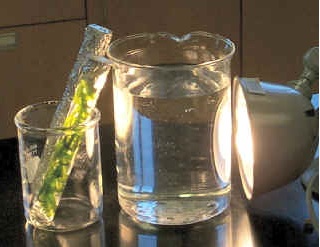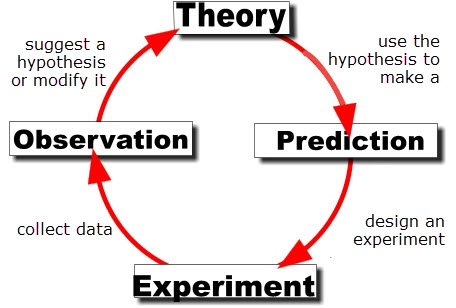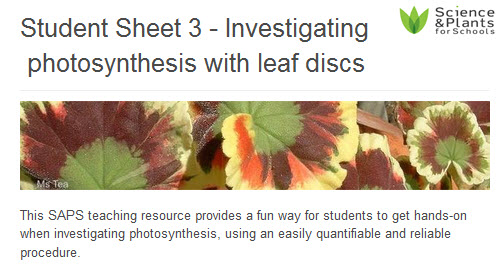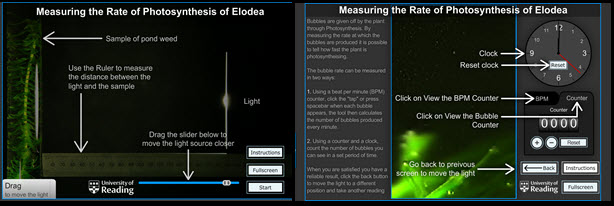Photosynthesis Experiments
 This activity introduces a simple method of measuring the rate of photosynthesis and leads students to design their own investigation of a factor which affects it. A second activity illustrates how the same could be achieved using a simulation. In a final activity using Scratch a more open ended model is introduced and students can test a range of hypotheses. The results of the wet lab could be compared to those of this final simple simulation. This experiment page could be used as an introduction to planning skills for the IA individual investigation. It could also illustrate how a model could be used to produce testable predictions for a wet lab.
This activity introduces a simple method of measuring the rate of photosynthesis and leads students to design their own investigation of a factor which affects it. A second activity illustrates how the same could be achieved using a simulation. In a final activity using Scratch a more open ended model is introduced and students can test a range of hypotheses. The results of the wet lab could be compared to those of this final simple simulation. This experiment page could be used as an introduction to planning skills for the IA individual investigation. It could also illustrate how a model could be used to produce testable predictions for a wet lab.
Lesson Description
Guiding Questions
- How can you make photosynthesis faster?
- Which variables can be limiting factors on photosynthesis?
- How can using a simulation or a model to make testable predictions and to collect data to support a theory?
Activity 1 - Floating Disc Photosynthesis - Wet Experiment
This is a great simple photosynthesis protocol which produces reliable results using fresh clover, radish or spinach leaves. This is a nice alternative to the usual photosynthesis experiments and once the method has been understood and has started working it can be easily adapted to provide data for a student investigation.
SAPS Floating leaf disc protocol.
To make this simple photosynthesis protocol into a mini investigation and to practise planning an IA individual experiment work through the steps on the ![]() Photosynthesis experiment design worksheet.
Photosynthesis experiment design worksheet.
Then carry your experiment about the rate of photosynthesis.
Activity 2 - Simulation of an Experiment to Measure the rate of photosynthesis
This activity will take you through the steps a student might take to design an Individual Investigation. You are going imagine that you have chosen to investigate photosynthesis
The activity will be based around the excellent Photosynthesis simulation: http://bit.ly/2g74kub from Reading University
Work through the steps on the ![]() Photosynthesis simulation worksheet to plan and carry out a little investigation of photosynthesis and light intensity.
Photosynthesis simulation worksheet to plan and carry out a little investigation of photosynthesis and light intensity.
.Photosynthesis worksheet to support ICT -5 Simulation & models requirement.
Activity 3 - Another more open ended simulation
This is a simple simulation which allows users to change a range of variables:
- the colour of the light,
- the brightness of the light and
- the carbon dioxide concentration.
It could even be remixed by students to use in their own IA Investigation. (See teacher's notes)
Explore the animation here: ![]() Scratch photosynthesis project
Scratch photosynthesis project
Work through the steps on the worksheet ![]() Scratch photosynthesis simulation worksheet
Scratch photosynthesis simulation worksheet
to plan and carry out a little investigation of photosynthesis and light intensity.
Teachers' notes
This page contains three ideas which can be used to measure the rate of photosynthesis. This covers the requirement for the IB guide on skills of designing experiments to investigate the effect of limiting factors on photosynthesis and to include the control of variables.
I think this activity will be an excellent way to introduce the Individual investigation.
The first activity is a simple and effective wet lab to measure the rate of photosynthesis in leaf discs. The limiting factors can be investigating by plotting graphs of rate against increasing light intensity, or increasing carbon dioxide content, by varying the concentration of the bicarbonate solution.
Photosynthesis experiments can be tricky, especially in winter months and so it is often simpler and quicker to measure results using a simulation. The second activity uses a simulation of the experiment to measure light intensity. This is very good but limited in scope.
Activity 3 introduces a Scratch animation to measure the rate of photosynthesis after varying a wider range of variables. This looks basic, but the results will show limiting factor of CO2 concentration when light intensity is increases, or vice versa. It can also be used to investigate three colours of light,or more than three wavelengths of light.
The great thing about this simulation is that it is quite easy for students to "remix" the model and change the calculation of the "bubble wait time" in the code. It would make a very good investigation to use activity one to perfect the code from the Scratch model. Look inside the scratch photosynthesis simulation project page here
(If anyone does this please do send me a copy of the write up and I will publish it on the site.)
Extra resources which didn't make it into the theory activity
Help with experimental design
- Forming Scientific Questions [PDF] - University of California
- Tomatosphere - Plant science Inquiry activities and resources
- Creating Testable Questions (Video on Tomatosphere™)
Video explanations of leaf disc labs
- Craig Kohns https://www.youtube.com/watch?v=XV9FOWleErA
- Bozeman science - walk through of the leaf discs lab
Alternative experiments
- Absorption spectra of chlorophyll a and b.
- Photosynthesis SL Quiz
- Photosynthesis worksheet to support ICT -5 Simulation & models requirement
An alternative simulation experiment designed by John McMurtry can be found here:

 IB Docs (2) Team
IB Docs (2) Team


